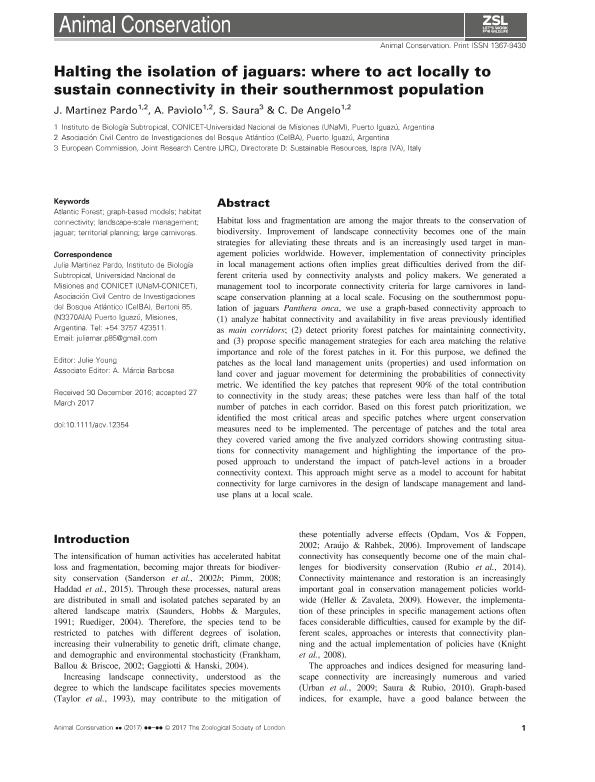Mostrar el registro sencillo del ítem
dc.contributor.author
Martínez Pardo, Julia

dc.contributor.author
Paviolo, Agustin Javier

dc.contributor.author
Saura, Santiago
dc.contributor.author
de Angelo, Carlos Daniel

dc.date.available
2018-05-22T21:24:27Z
dc.date.issued
2017-05
dc.identifier.citation
Martínez Pardo, Julia; Paviolo, Agustin Javier; Saura, Santiago; de Angelo, Carlos Daniel; Halting the isolation of jaguars: Where to act locally to sustain connectivity in their southernmost population; Wiley Blackwell Publishing, Inc; Animal Conservation; 20; 6; 5-2017; 543-554
dc.identifier.issn
1367-9430
dc.identifier.uri
http://hdl.handle.net/11336/45965
dc.description.abstract
Habitat loss and fragmentation are among the major threats to the conservation of biodiversity. Improvement of landscape connectivity becomes one of the main strategies for alleviating these threats and is an increasingly used target in management policies worldwide. However, implementation of connectivity principles in local management actions often implies great difficulties derived from the different criteria used by connectivity analysts and policy makers. We generated a management tool to incorporate connectivity criteria for large carnivores in landscape conservation planning at a local scale. Focusing on the southernmost population of jaguars Panthera onca, we use a graph-based connectivity approach to (1) analyze habitat connectivity and availability in five areas previously identified as main corridors; (2) detect priority forest patches for maintaining connectivity, and (3) propose specific management strategies for each area matching the relative importance and role of the forest patches in it. For this purpose, we defined the patches as the local land management units (properties) and used information on land cover and jaguar movement for determining the probabilities of connectivity metric. We identified the key patches that represent 90% of the total contribution to connectivity in the study areas; these patches were less than half of the total number of patches in each corridor. Based on this forest patch prioritization, we identified the most critical areas and specific patches where urgent conservation measures need to be implemented. The percentage of patches and the total area they covered varied among the five analyzed corridors showing contrasting situations for connectivity management and highlighting the importance of the proposed approach to understand the impact of patch-level actions in a broader connectivity context. This approach might serve as a model to account for habitat connectivity for large carnivores in the design of landscape management and land-use plans at a local scale.
dc.format
application/pdf
dc.language.iso
eng
dc.publisher
Wiley Blackwell Publishing, Inc

dc.rights
info:eu-repo/semantics/openAccess
dc.rights.uri
https://creativecommons.org/licenses/by-nc-sa/2.5/ar/
dc.subject
Atlantic Forest
dc.subject
Graph-Based Models
dc.subject
Habitat Connectivity
dc.subject
Jaguar
dc.subject
Landscape-Scale Management
dc.subject
Large Carnivores
dc.subject
Territorial Planning
dc.subject.classification
Otras Ciencias Biológicas

dc.subject.classification
Ciencias Biológicas

dc.subject.classification
CIENCIAS NATURALES Y EXACTAS

dc.title
Halting the isolation of jaguars: Where to act locally to sustain connectivity in their southernmost population
dc.type
info:eu-repo/semantics/article
dc.type
info:ar-repo/semantics/artículo
dc.type
info:eu-repo/semantics/publishedVersion
dc.date.updated
2018-05-16T14:45:02Z
dc.identifier.eissn
1469-1795
dc.journal.volume
20
dc.journal.number
6
dc.journal.pagination
543-554
dc.journal.pais
Reino Unido

dc.journal.ciudad
Londres
dc.description.fil
Fil: Martínez Pardo, Julia. Consejo Nacional de Investigaciones Científicas y Técnicas. Centro Científico Tecnológico Conicet - Nordeste. Instituto de Biología Subtropical. Instituto de Biología Subtropical - Nodo Puerto Iguazú | Universidad Nacional de Misiones. Instituto de Biología Subtropical. Instituto de Biología Subtropical - Nodo Puerto Iguazú; Argentina
dc.description.fil
Fil: Paviolo, Agustin Javier. Consejo Nacional de Investigaciones Científicas y Técnicas. Centro Científico Tecnológico Conicet - Nordeste. Instituto de Biología Subtropical. Instituto de Biología Subtropical - Nodo Puerto Iguazú | Universidad Nacional de Misiones. Instituto de Biología Subtropical. Instituto de Biología Subtropical - Nodo Puerto Iguazú; Argentina
dc.description.fil
Fil: Saura, Santiago. Joint Research Centre; Italia
dc.description.fil
Fil: de Angelo, Carlos Daniel. Consejo Nacional de Investigaciones Científicas y Técnicas. Centro Científico Tecnológico Conicet - Nordeste. Instituto de Biología Subtropical. Instituto de Biología Subtropical - Nodo Puerto Iguazú | Universidad Nacional de Misiones. Instituto de Biología Subtropical. Instituto de Biología Subtropical - Nodo Puerto Iguazú; Argentina
dc.journal.title
Animal Conservation

dc.relation.alternativeid
info:eu-repo/semantics/altIdentifier/url/http://onlinelibrary.wiley.com/doi/10.1111/acv.12354/abstract
dc.relation.alternativeid
info:eu-repo/semantics/altIdentifier/doi/http://dx.doi.org/10.1111/acv.12354
dc.relation.alternativeid
info:eu-repo/semantics/altIdentifier/url/https://zslpublications.onlinelibrary.wiley.com/toc/14691795/20/6
Archivos asociados
